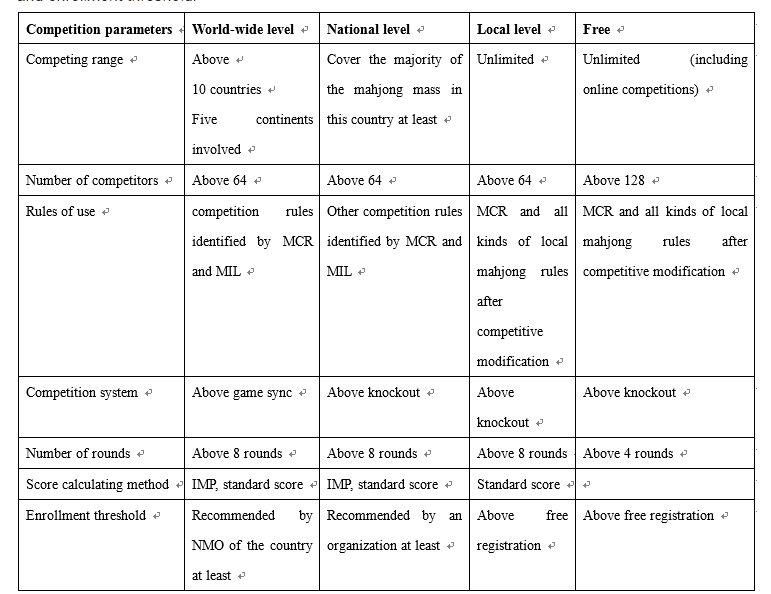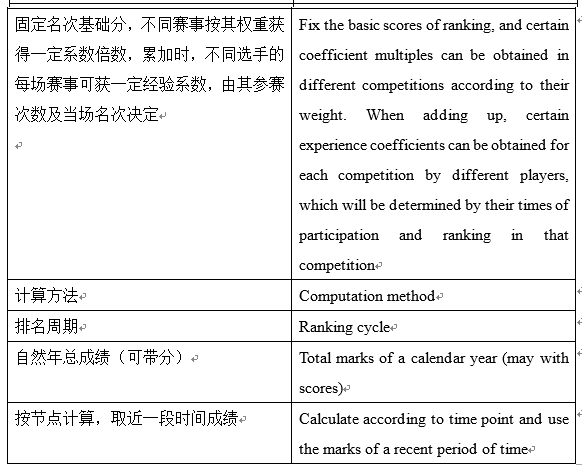MASTER RANKING INSTRUCTION
一、MIL颁布实施了麻将运动全球推广计划(试行)以及麻将选手等级和技术水平认证办法(试行)
In order to promote mahjong in the competitive, standardized and sportified orientation, and make it join the world mind sports family as early as possible, this program is developed after discussion by MIL Game Committee. It is to be referred to by the global mahjong fans and mahjong organizations on a trial basis.
二、MIL大师分赛事遴选
遴选原则:涉及中国大陆选手参加的,MIL主办、授权、指导的各项赛事,含与MIL有合作关系的组织所办赛事,且符合相关标准。
时间节点:2015年MIL成立至2017年初,麻将作为智力运动观察员阶段;2017年初至2022年12月31日,竞技麻将成为正式的国际智力运动阶段
MCR赛事摘要:
(1)2015年MIL成立至2017年初,麻将作为智力运动观察员阶段,以MIL官网已公布的大师分为准,已涵盖了符合上述原则的相关赛事,并衰减50%;
(2)2017年至今,历次WMMG直通赛;
(3)2017年至今的牌王赛/大师赛,俱乐部联赛;
(4)盛殿、方庄2017年至今的规范联赛;同时,对于C级赛事,原则要求“6局+ 48人”,低于此标准的赛事,此次未收录。
(5)瘦西湖杯/新月光杯/CMT宁波团体赛/2021年山盟赛;
(6)台北直通赛、日本选手权、欧亚精英交流赛、俄罗斯复式赛、欧洲线上复式赛、南洋新雀智力运动赛
(7)其它相关赛事
RCR赛事摘要:
(1)历次WMMG直通赛(北京站、澳门站);
(2)部分国际立直麻将赛事
三、MIL大师分计算方法


四、详细说明
I. Principle of competition system construction
The competition is required to conform to the development law of modern sports and reflect such characteristics as competitiveness, standardization and sportification.
1. Competitiveness: The competitive nature has to be reflected in the rules and competition system. Firstly, the rules used in mahjong competitions should reflect the competitive nature, such as MCR, Japanese style and local rules after competitive modification. At present, the rules used in the world-wide level competitions hosted by MIL is based on the Chinese Mahjong Competition Rules (trial) issued by General Administration of Sport of China in 1988 and it is adaptively adjusted according to the sources of competitors. Secondly, the competition system applied in mahjong competitions should reflect the competitive nature and the competition process and result should be comparable. At present, the competition system used by world-wide level competitions hosted by MIL is duplicate competition, including group and individual duplicate competitions.
2. Standardization: Competitor selection and competition management specifications should conform to the organization standard for the international mind sports.
3. Sporty nature: The sporty nature is reflected in two aspects. First, the competitors and organizations engaged in mahjong competitions should conform to the general standard of mahjong; second, the foundation and actions to develop the mass engagement of mahjong are available.
II. Competition system grading
MIL pushes mahjong to be among the mind sports and divided into competitions of different levels, including World-wide level, Continent/National level, Local level and Free competitions in sequence. The parameter setting standards for competitions of different levels vary accordingly.
III. Guidelines for parameter setting of mahjong mind sports competition
Mahjong mind sports competition parameters encompass the competing range, number of competitors, rules of use, number of rounds, competition system and enrollment threshold.


Remarks: Above XX (XX included). If the relatively strict qualification selection rules are followed, the restrictions on the number of competitors can be relaxed.
IV. Connotation of each parameter:
1. Rules of use
Original local rules < all kinds of local rules after competitive modification < other competition rules identified by MIL < MCR
MCR: rules based on Chinese Mahjong Competition Rules (trail) issued by General Administration of Sport of China in 1998.
Other competition rules identified by MIL: relatively mature competitive mahjong rules at present, which is used as the general MIL competition rules after identified by MIL Rule Committee
All kinds of local mahjong rules after competitive modification: based on the original local rules competitive modification
Original local rules: playing methods popular in various regions in the world at present
2. Competition system
Knockout < Round-robin < Game Sync < Duplicate Competition System < Duplicate Optimization
Knockout: There must be at least 4 rounds in the knockout
Round-robin: The game is arranged before the competition, such as 4th WMC
Game Sync: The latest game seating arrangement is based on the real-time result of the last game, such as Swiss Movement and serpentine seat arrangement.
Duplicate competition system: duplicate competition system based on individuals and group respectively.
Duplicate optimization: optimization combining knock-out, game synchronization, etc. based on basic duplicate competition
3. Number of rounds
It refers to the number of effective rounds required to take the championship in individual competition and four turns compose on round (number of rounds shall be calculated as the number of turns divided by 4 under different rules)
4.Score calculating method
Competition score< standard score< IMP
Competition score: Sum of the sub-scores of the whole competition or standard scores converted by sub-scores in the whole competition
Standard score: 4210, 4321 or other variants
IMP: exclusive for duplicate competition
5. Enrollment threshold:
free enrollment< organization recommendation< part from selection competition< all from selection competition
Free enrollment: subject to the actual assessment results of the competition assessment specialists
Organization recommendation: recommendation by NMO or other famous organizations
Part from selection competition: part of players are selected through selection competition or other selection mechanism, such as 1st WMSG.
All from selection competition: all the players are selected through the selection competition or the regional rankings, such as Tencent TMT Championships and EMA player of the European Mahjong Championship
IV. MIL Master Score Plan
In order to establish a standardized mahjong mind sports competition system, MIL plans to launch the master score plan in an attempt to count and measure the real-time performance of global players and accumulate data for later player classification and access to competition.






All the competitions organized by MIL members are tacitly approved as the sources of MIL master scores.
Competitions organized by organizations other than MIL members can be applied to become the source competitions of MIL master scores and the MIL Competition Committee will appoint the authentication officer to conduct on-the-spot check and then it will be included in the MIL master scores.
As for competitions other than MIL member competitions that have not applied to become the source of MIL master scores, MIL will calculate its analog master scores, which will be listed and published separately to provide reference to the organizations and mahjong players all around the world.
V. Calculation method of MIL master scores
In the trial operation phase of the MIL master score system, the marks of global players obtained in MIL certified competitions will be counted and according to the following standards, the marks of players will be converted into corresponding master scores.
In a calendar year, the master scores obtained by players in different competitions can be accumulated. After a calendar year ends, the master scores of players will be counted into the next year’s scores by certain proportion. Such a design gives consideration to real-time performance and also certain recognition to the history scores of players.
As for mahjong competitions applying to enter the MIL master score system, MIL Committee of Competition Certification will give overall consideration to such factors as competing range, number of players, rules, competition system, rounds, scoring method, participation requirements and frequency, classify the certified competition into five levels of S, A, B, C, D and endow the master score weight coefficient x.
Level S: world-wide level competitions of high level in general (x=60)
Level A: competitions of high level of and above national level (included). (x=20)
Level B: national level competitions, or competitions recognized by MIL with the same level as national level. (x=5)
Level C: local level competitions of higher level in general (x=1)
Level D: part of local level competitions, free competitions, network competitions, etc. (x not set)
Reference Table of Competition Ranking and Master Score:
Competition of Level S/A/B/C:
No. 1: 100x
No. 2: 80x
No. 3: 70x
No. 4: 60x
No. 5-8: 50x
No. 9-16: 25x
Top 25% in competitions of Level S/A/B: 15x
Top 50% in competitions of Level S/A: 5x
Finish competitions of Level S: x
Competitions of Level D:
No. 1: 10
No. 2: 6
No. 3: 3
No. 4: 1
For example, in a calendar year, a player ranking 100th in the competition of Level S with 200 entries (top 50%) will obtain 5*60=300 master scores. The player ranks 70th in the competition of Level A with 128 entries (not in the top 50%) and will not obtain master scores. The player wins the championship for one time in the competition of Level B and will obtain 100*5=500 master scores. The player ranks 3rd and 6th each in the competition of Level C and will obtain 70+50=120 master scores in total. The player ranks 1th, 2nd, 3rd and 4th each for twice in the competition of Level D and will obtain (10+6+3+1)*2=40 master scores in total. Adding up the above scores, the master scores obtained by this player in the calendar year will be 960.